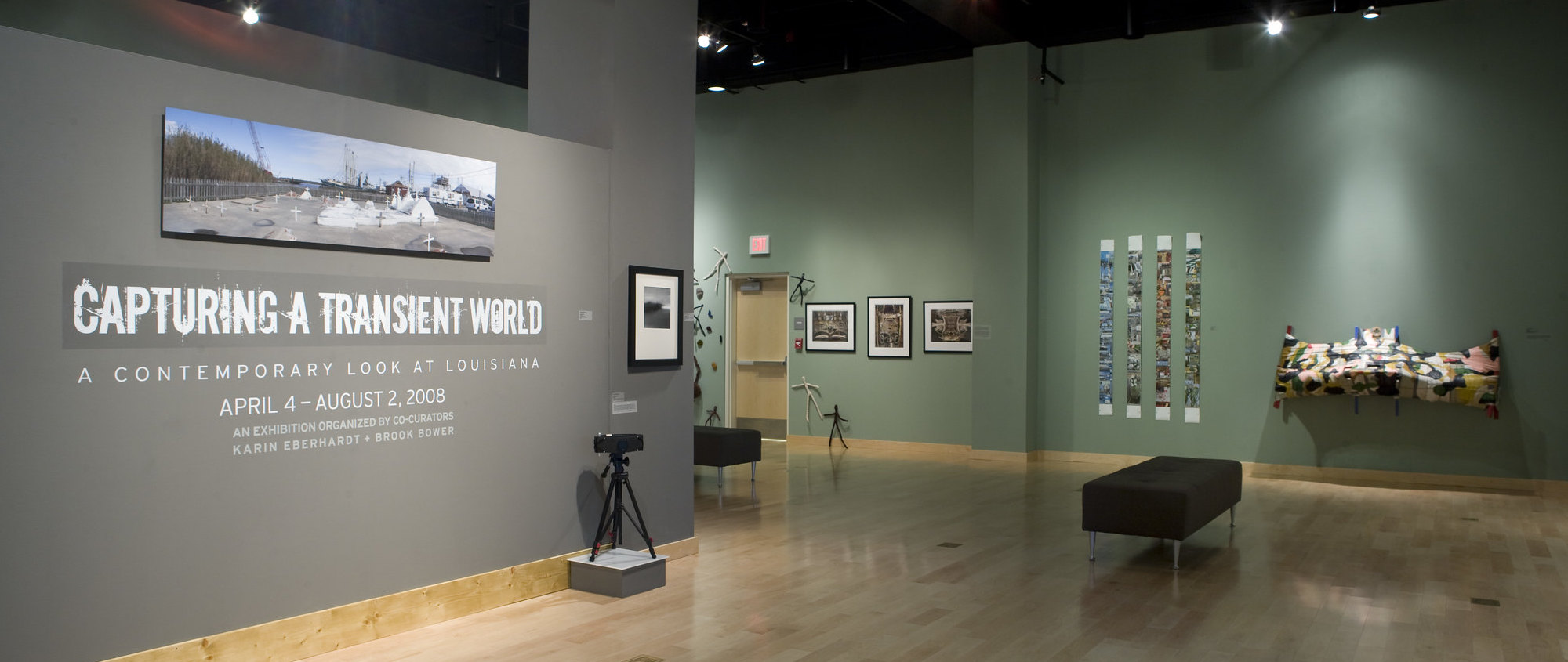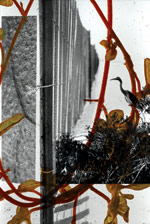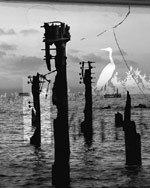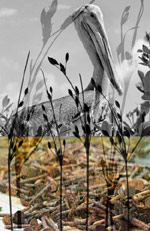Capturing a Transient World features eleven artists who present an interpretative, multi-media response to the multiplicity of ideas and complex issues surrounding coastal Louisiana. Through the eyes of contemporary artists employing this theme in their art, this collective body of work captures the ecological tension between man and nature and investigates the adverse effects of coastal erosion on the rich Louisianan culture and way of life. Participating artists include: Matthew Brazier, Chuck Broussard, Karin Eberhardt, Yvonne James, Daniel Kariko, Delaina LeBlanc, Scott Ludwig, F. Tobias Morriss, Caesendra Seawell, Michael Wyshock, and Dennis Sipiorski.
This exhibition is presented in conjunction with IN Black & White, an exhibition that presents photographs investigating Louisiana’s coastline from Louisiana Universities Marine Consortium’s Permanent Collection

Karin Eberhardt; Entreat, Raccoon Island, Timbalier Island, Louisiana; 2007. Digital montage. Photo credit: copyright 2007, courtesy of the artist.
Karin Eberhardt; Raccoon Island, Sulfur Mine, Louisiana; 2007. Digital montage. Photo credit: copyright 2007, courtesy of the artist.
About the curators
Karin Eberhardt, Assistant Professor of Design, Southeastern Louisiana University, joined TCVA Assistant Curator Brook Bower to curate this powerful exhibition focused on the coastal lands of Louisiana. Every action initiates a reaction. In the case of the Barrier Islands, the safeguard of Louisiana, the marshes and estuaries are diminishing so rapidly that researchers and artists can do little but document its imminent disappearance. As levees are built and rebuilt, the Mississippi is redirected, and storms come and go, so does the landmass that makes up the magnificent and endangered Louisiana coast.
About the artists
Artists include:
- Matthew Brazier, Crawfordville, FL
- Yvonne James, Folsom, LA
- Delaina LeBlanc, Tallahassee, FL
- Scott Ludwig, Boone, NC
- Caesandra Seawell, Buffalo, NY
- Michael Wyshock, Oneonta, NY
- and the following…
Chuck Broussard, Layfaette, LA
Chuck Broussard is a native Cajun from the heart of South Louisiana. His paintings depict the culture and environment in which he was raised. He grew up in the small rural town of Scott, in western Lafayette Parish. The second of eight children, Chuck recalls that art was often encouraged by both of his parents. On rainy days, his mom, Rita would rip off a sheet of freezer paper, turn it rough side up, and request a crayon drawing of an undersea, or farm, or circus scene in order to occupy the kids’ time and attention. His dad, Lastie, would then critique it as it was displayed on the bamboo blinds in the den.
Chuck first tried his hand at oils about ten years ago. Prior to that he dabbled with watercolors and pastels, never emotionally connecting with the medium in the way he has with oils. “There is just something about the depth and richness of color that draws me to oils. The scent of the turpentine and linseed oil makes me feel like I am a “real” artist. It follows me when I leave the easel and signals my friends that I have been creating art.” Broussard will occasionally still paint in acrylics or water colors for a change of pace or to do something whimsical, such as the pirogues on display.
“I chose the rotting pirogues to frame my depictions of our vanishing Louisiana. Physically and culturally, we are losing some of the historic icons that have rooted us to the thick alluvial mud in which we have imprinted our lives. The Virgin Mary shares space with live oaks and Roseate Spoonbills as symbols of our relationship with our surroundings and our Roman Catholic tradition. The connection is as thick as our gumbo roux.”
Broussard’s work is handled by several Louisiana galleries: The Frame Shop and Gallery 912 in Lafayette, Jean Bragg Gallery of Southern Art in New Orleans, and Taylor Clark Gallery in Baton Rouge. He is becoming widely and seriously collected as a native southern artist.
Karin Eberhardt, Ponchatoula, LA
Native of New Orleans, Karin Eberhardt is an artist, teacher, and graphic designer. Her interest lies in digital collage, typography, and sustainable design.
Representing a unique combination of environmental advocacy and contemporary landscape, her most recent series of digital collages, Still Life, seek to unveil the intrinsic, mysterious beauty of coastal Louisiana and respectfully give permanency to it’s ephemeral environment.
Karin serves on the Artist Advisory for the St. Tammany Art Association and is an active member of AIGA New Orleans. She is a founding member of the Friends of the Chauvin Sculpture Garden and currently serves as Advertising and Promotions Coordinator.
Karin holds an MFA, Multimedia Design from Louisiana State University and a BA, Graphic Design from Nicholls State University and currently teaches at Digital Design at Southeaster State Louisiana.
Daniel Kariko, Tallahassee, FL
Daniel Kariko was born in 1976 in Novi Sad, Yugoslavia, now Northern Serbia. He moved to United States in November of 1994 and finished his high school education in Southern Louisiana.
After high school Kariko enrolled in engineering program at Nicholls State University in Thibodaux, Louisiana. He soon switched his interest to art photography, and graduated four years later with Bachelor of Arts degree.
In 1999 Kariko was accepted to Masters of Fine Arts program at Arizona State University in Phoenix, Arizona. He was awarded Arizona-Austria Travel Grant, and spent a month as a guest of the Land of Salzburg, in summer of 2001.
Kariko is currently a Florida State University faculty, where he teaches Photography and Digital Imaging, and manages the photography facilities.
F. Tobias Morriss, Lexington, SC
I am a simple person. I shy away from complexity. I don’t need it.
My thoughts occur in images and not words. When I attempt to attach words to the thoughts, they fleet. I communicate best through photography. I capture what beckons me and figure out what it means after the fact. Most of the time it is part of my being that lies below the surface trying to come through and be understood. It is my heart or soul talking to my conscious. I figure out a little more about my inner self through my art. I strive to make the photographs be the end not a means to the end. I try to make a photograph as something rather than a photograph of something. I hope you look at my work instead of what I have photographed.
Dennis Sipiorski, Covington, LA
Dennis Sipiorski currently teaches Ceramics and serves as the Department Head for the Visual Arts Department at Southeastern Louisiana State University. He received a MFA in Ceramics from the University of Notre Dame and has two degrees in Education from the University of Wisconsin.
During the 25+ years I’ve spent in Louisiana, my art work has changed many times. I am mainly a storyteller and my work illustrates the images and subjects in my day-to-day world. The style of my work is flat and direct. I use many media in addition to clay—metal, watercolors, oils, photography. Each media is picked because of the unique qualities that it brings to the finished piece.
Clay is soft and moves easily, metal is hard and strong. Photography stops time and is a shadow of a moment. My images come from many sources in my past and present—growing up in the Midwest, Catholic school, college and southern Louisiana. Many of my current images come directly from my backyard- frogs, rabbits, cats, birds, fish, alligators, dogs, armadillos, snakes, along with plants, flowers, banana trees, magnolias, etc. The relationship of these images—how I place them on the piece—creates the stories.
I’m not trying to create a new art form. My work simply tells the viewer what I consider important in my life. All of these subjects have been used many times throughout the centuries. All of these past images are noted and sometimes incorporated into my work. I hope my stories are universal to the viewer. I want my work to ask questions about life, but not necessarily produce all of the answers.
–Excerpt from Arts & Activities, Oct. 2000 by Harriet Gamble.



